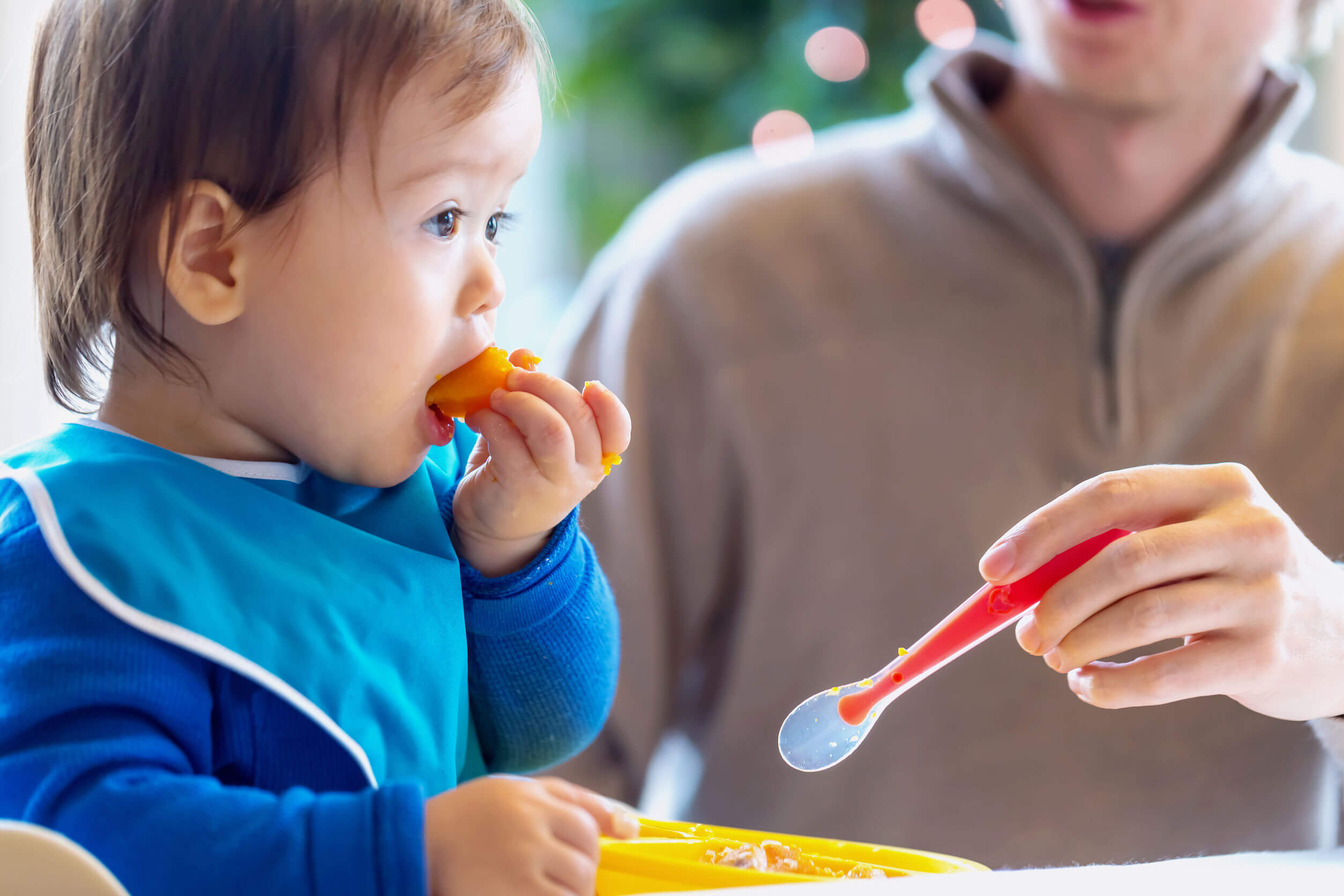Chewing Problems in Children


Written and verified by the dentist Vanesa Evangelina Buffa
Making sure that young children get all the nutrients they need is a common concern of their parents. Sometimes, in the attempt to ensure that they eat a variety of foods, soft foods are prolonged and chewing problems appear in children.
Chewing is a skill that babies acquire as they grow. Offering them solid foods, in small pieces, and accompanying them in their learning, is fundamental.
In the following article, we’ll tell you how babies learn to chew and the problems that can occur during this process. We’ll also mention some tips to help little ones exercise this practice.
The chewing process
Chewing is the function that prepares food in the mouth to facilitate its passage to the esophagus and then to the stomach, in order to be digested. This mechanism is learned by the child and is necessary for the correct growth of the orofacial structures.
Structures such as the teeth, jaws, cheeks, palate, lips, and temporomandibular joint are involved in the chewing process. The muscles of mastication are responsible for giving mobility to the maxillary bones, allowing the jaw to open and close.

During mastication, the growth of the structures involved in the process is promoted. For this reason, it’s important for children to strengthen and improve their movements until they can chew on both sides.
The best time for children to start practicing this new function is after 6 months of age. When the teeth erupt, food can be offered in pieces, gradually and progressively incorporating new flavors and textures.
The child should follow an evolutive process in the foods they incorporate. In the beginning, soft consistencies are offered, such as porridges and purees, and then harder textures are added.
“Other important aspects of feeding and complementary foods include attention to food texture, reflecting the child’s ability to chew and swallow, appropriate meal frequency, energy density, and nutrient content, and the use of vitamin and mineral supplements or fortified products, when necessary.”
– World Health Organization (WHO) –
It’s important that adults supervise and accompany the moments when babies are fed. Not only to avoid accidents but also so that the little ones can imitate the chewing movements of the older members of the family.
Causes of chewing problems in children
Chewing, as already mentioned, is important for the correct development of the child’s orofacial structures. In addition, it’s vital for the correct digestion of food, having a fundamental role in nutrition.
But sometimes this function is altered, which hinders feeding and the correct oral growth of little ones. The most common cause of a chewing problem in children is the lack of adequate stimulation.
Prolonged soft feeding, without the incorporation of solid foods, makes children unable to exercise the necessary movements and strengthen the masticatory structures.
Some may present food selectivity or food rejection. The causes of these problems may be due to a combination of medical, behavioral, and sensorimotor factors.
Chewing problems in children may be due to alterations in the structures involved in the process, such as bones and teeth. The loss of teeth, malpositioned teeth, tooth mobility, or tooth pain, for example, are causes of difficult chewing.
Functional disorders, such as mouth breathing, or dysfunctional habits that prolong infant feeding can also be the origin of this problem.
Often, the intervention of specialists, such as orthodontists and speech therapists, is necessary to reverse the causes behind chewing problems in children. Consulting and clearing up all your doubts about the feeding process is the ideal way to accompany them at this stage.

What are the most common chewing problems in children?
Beyond the cause that originates them, some of the following chewing problems in children may occur:
- One-sided chewing: Some toddlers become accustomed to chewing on one side only. This can affect occlusal balance, and generate tension and pain in the muscles of the face, head, neck, and back. It also generates asymmetries in facial growth, alterations in posture, and malocclusions.
- Malocclusions: Teeth that don’t come into contact as they should or jaws that don’t relate correctly are chewing problems in children. Therefore, crossbites, open bites, crowded teeth, diastemas, and overbites are situations that alter chewing in children.
- Painful chewing: Painful teeth due to cavities, infections, nerve inflammation, or fractures are the cause of impaired chewing. It can also be affected by soft tissue injuries, such as inflammatory processes, canker sores, and blisters. Problems in the temporomandibular joint also cause pain when chewing.
- Speech disorders: Chewing problems hinder the correct development of the structures involved in speech. Thus, the articulation of some phonemes can be affected when chewing isn’t performed properly.
Tips to help your child chew
Some chewing problems in children can’t be avoided, but stimulating this function can prevent several inconveniences. These tips should be taken into account when feeding little ones:
- Introduce new foods: Offer different flavors and textures each week, increasing the hardness of foods progressively. Stop mashing foods or mash vegetables with a fork, for example, so that your child comes into contact with larger pieces that exercise chewing.
- Let the child eat alone: Allowing the child to eat what they choose from the plate with their hands helps them to explore the food, gain autonomy, and improve their motor skills and coordination.
- Create a quiet moment: Distractions such as television should be avoided and a pleasant environment should be created.
- Eat with the child: Share the table and serve them the same food that everyone else eats (unless it’s a very hard or dangerous food). Sitting with adults stimulates the child to imitate movements.
- Be patient: Learning this skill requires perseverance, time, and understanding. Avoid insisting or scolding the child during feeding. If the child refuses to eat solids, try another time and don’t insist at that moment.

- Avoid dangerous foods: Don’t offer very hard or small foods because of the risk of choking. In addition, nutritious and natural foods without the addition of preservatives, salt, or sugar should be preferred.
- Motivate the child: When the child has already achieved the skill, it’s time to encourage them to do it correctly. Attention should be paid to chewing with the mouth closed, on both sides, and several times before swallowing. Encouraging them to do it better and better is ideal.
Accompany the learning process
Sometimes little ones resist the new textures of solid foods. In addition, they may feel fatigued by the increased effort involved in chewing. Practicing is the key for them to evolve in their feeding and avoid chewing problems. Curiosity will be what motivates them the most to learn new movements needed in order to eat.
It’s important to remember that each child has their own learning time. The accompaniment of adults, with love, creativity, and respect is fundamental to helping them progress in their attempts.
Making sure that young children get all the nutrients they need is a common concern of their parents. Sometimes, in the attempt to ensure that they eat a variety of foods, soft foods are prolonged and chewing problems appear in children.
Chewing is a skill that babies acquire as they grow. Offering them solid foods, in small pieces, and accompanying them in their learning, is fundamental.
In the following article, we’ll tell you how babies learn to chew and the problems that can occur during this process. We’ll also mention some tips to help little ones exercise this practice.
The chewing process
Chewing is the function that prepares food in the mouth to facilitate its passage to the esophagus and then to the stomach, in order to be digested. This mechanism is learned by the child and is necessary for the correct growth of the orofacial structures.
Structures such as the teeth, jaws, cheeks, palate, lips, and temporomandibular joint are involved in the chewing process. The muscles of mastication are responsible for giving mobility to the maxillary bones, allowing the jaw to open and close.

During mastication, the growth of the structures involved in the process is promoted. For this reason, it’s important for children to strengthen and improve their movements until they can chew on both sides.
The best time for children to start practicing this new function is after 6 months of age. When the teeth erupt, food can be offered in pieces, gradually and progressively incorporating new flavors and textures.
The child should follow an evolutive process in the foods they incorporate. In the beginning, soft consistencies are offered, such as porridges and purees, and then harder textures are added.
“Other important aspects of feeding and complementary foods include attention to food texture, reflecting the child’s ability to chew and swallow, appropriate meal frequency, energy density, and nutrient content, and the use of vitamin and mineral supplements or fortified products, when necessary.”
– World Health Organization (WHO) –
It’s important that adults supervise and accompany the moments when babies are fed. Not only to avoid accidents but also so that the little ones can imitate the chewing movements of the older members of the family.
Causes of chewing problems in children
Chewing, as already mentioned, is important for the correct development of the child’s orofacial structures. In addition, it’s vital for the correct digestion of food, having a fundamental role in nutrition.
But sometimes this function is altered, which hinders feeding and the correct oral growth of little ones. The most common cause of a chewing problem in children is the lack of adequate stimulation.
Prolonged soft feeding, without the incorporation of solid foods, makes children unable to exercise the necessary movements and strengthen the masticatory structures.
Some may present food selectivity or food rejection. The causes of these problems may be due to a combination of medical, behavioral, and sensorimotor factors.
Chewing problems in children may be due to alterations in the structures involved in the process, such as bones and teeth. The loss of teeth, malpositioned teeth, tooth mobility, or tooth pain, for example, are causes of difficult chewing.
Functional disorders, such as mouth breathing, or dysfunctional habits that prolong infant feeding can also be the origin of this problem.
Often, the intervention of specialists, such as orthodontists and speech therapists, is necessary to reverse the causes behind chewing problems in children. Consulting and clearing up all your doubts about the feeding process is the ideal way to accompany them at this stage.

What are the most common chewing problems in children?
Beyond the cause that originates them, some of the following chewing problems in children may occur:
- One-sided chewing: Some toddlers become accustomed to chewing on one side only. This can affect occlusal balance, and generate tension and pain in the muscles of the face, head, neck, and back. It also generates asymmetries in facial growth, alterations in posture, and malocclusions.
- Malocclusions: Teeth that don’t come into contact as they should or jaws that don’t relate correctly are chewing problems in children. Therefore, crossbites, open bites, crowded teeth, diastemas, and overbites are situations that alter chewing in children.
- Painful chewing: Painful teeth due to cavities, infections, nerve inflammation, or fractures are the cause of impaired chewing. It can also be affected by soft tissue injuries, such as inflammatory processes, canker sores, and blisters. Problems in the temporomandibular joint also cause pain when chewing.
- Speech disorders: Chewing problems hinder the correct development of the structures involved in speech. Thus, the articulation of some phonemes can be affected when chewing isn’t performed properly.
Tips to help your child chew
Some chewing problems in children can’t be avoided, but stimulating this function can prevent several inconveniences. These tips should be taken into account when feeding little ones:
- Introduce new foods: Offer different flavors and textures each week, increasing the hardness of foods progressively. Stop mashing foods or mash vegetables with a fork, for example, so that your child comes into contact with larger pieces that exercise chewing.
- Let the child eat alone: Allowing the child to eat what they choose from the plate with their hands helps them to explore the food, gain autonomy, and improve their motor skills and coordination.
- Create a quiet moment: Distractions such as television should be avoided and a pleasant environment should be created.
- Eat with the child: Share the table and serve them the same food that everyone else eats (unless it’s a very hard or dangerous food). Sitting with adults stimulates the child to imitate movements.
- Be patient: Learning this skill requires perseverance, time, and understanding. Avoid insisting or scolding the child during feeding. If the child refuses to eat solids, try another time and don’t insist at that moment.

- Avoid dangerous foods: Don’t offer very hard or small foods because of the risk of choking. In addition, nutritious and natural foods without the addition of preservatives, salt, or sugar should be preferred.
- Motivate the child: When the child has already achieved the skill, it’s time to encourage them to do it correctly. Attention should be paid to chewing with the mouth closed, on both sides, and several times before swallowing. Encouraging them to do it better and better is ideal.
Accompany the learning process
Sometimes little ones resist the new textures of solid foods. In addition, they may feel fatigued by the increased effort involved in chewing. Practicing is the key for them to evolve in their feeding and avoid chewing problems. Curiosity will be what motivates them the most to learn new movements needed in order to eat.
It’s important to remember that each child has their own learning time. The accompaniment of adults, with love, creativity, and respect is fundamental to helping them progress in their attempts.
All cited sources were thoroughly reviewed by our team to ensure their quality, reliability, currency, and validity. The bibliography of this article was considered reliable and of academic or scientific accuracy.
- Arias Rodriguez, Jose Luis. “Análisis de la masticación unilateral en niños de 3-6 años atendidos en el servicio de pediatría del Hospital Regional Honorio Delgado Espinoza 2017.” (2017).
- López Diez, Marina. “La importancia de las texturas de los alimentos y la masticación: Revisión sistemática.” (2017).
- Morejón Barrueto, Yanet, and Shuyeng Acea Vanega. “La terapia de alimentación en los problemas del lenguaje en los niños.” MediSur 13.4 (2015): 472-474.
- Reyes, David Parra. “Adecuación orofacial para facilitar la masticación y deglución en niños con PCI.” REVISTA CIENTÍFICA SIGNOS FÓNICOS 1.2 (2015): 36-38.
- Chueca, Antonio Sarría, and Jesús Fleta Zaragozano. “Problemas de los niños a la hora de comer. Comedores resistentes y neofobia alimentaria.” Boletín de la Sociedad de Pediatría de Aragón, La Rioja y Soria 39.1 (2009): 12-16.
- Black, Maureen M., and Hilary M. Creed-Kanashiro. “¿ Cómo alimentar a los niños?: La práctica de conductas alimentarias saludables desde la infancia.” Revista Peruana de medicina experimental y salud pública 29.3 (2012): 373-378.
- Manrique, Marta Vega Velasco. “Alimentación complementaria guiada por el bebé: respetando sus ritmos y apoyando su aprendizaje.” Medicina naturista 8.2 (2014): 64-72.
- Quintero, LN Mónica. “Mitos y Realidades Sobre la Alimentación Complementaria.”
This text is provided for informational purposes only and does not replace consultation with a professional. If in doubt, consult your specialist.








